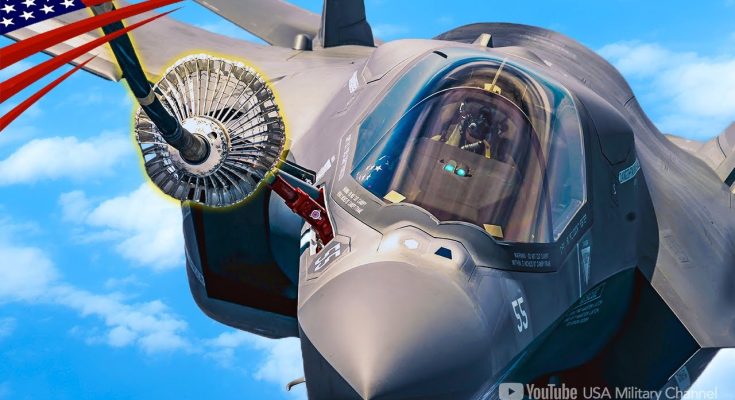The F-35B and F-35C variants of the Lockheed Martin F-35 Lightning II are two of the most advanced multirole stealth fighters in the world, designed to meet the needs of both the U.S. Navy and Marine Corps. While the F-35A is the conventional takeoff and landing version, the F-35B and F-35C are optimized for short takeoff and vertical landing (STOVL) and carrier operations, respectively. One of the key capabilities that enhances their operational flexibility is aerial refueling, specifically using the probe-and-drogue system. This method allows the F-35B and F-35C to extend their range and stay airborne for longer periods, a critical asset in both combat and long-duration missions.
The Probe-and-Drogue Refueling System
Aerial refueling is an essential technique for extending the operational range of aircraft, and the probe-and-drogue system is one of the most commonly used methods, especially for naval and Marine Corps aircraft. In this system, the aircraft to be refueled (the receiver) carries a retractable refueling probe mounted on the aircraft’s fuselage or wing. The tanker aircraft, typically a KC-135 Stratotanker or a KC-46 Pegasus, deploys a drogue (a conical device attached to a hose) that trails behind the aircraft. The receiving aircraft’s probe is then extended into the drogues, allowing fuel to flow from the tanker to the receiver.
For F-35B and F-35C pilots, mastering the probe-and-drogue aerial refueling procedure requires incredible skill, precision, and focus. Unlike the traditional boom-and-receptacle system used by larger aircraft, probe-and-drogue refueling involves a more delicate and dynamic process of connection and fuel transfer. This method is particularly useful for aircraft like the F-35B and F-35C, which operate from aircraft carriers or forward-deployed locations with limited space for refueling infrastructure.
Pilots with Mad Skills: Aerial Refueling in Action
F-35B/C pilots must exhibit a high level of skill to execute probe-and-drogue refueling successfully, particularly in challenging environments such as turbulent air, low visibility, or at night. These pilots are trained to execute the precise positioning necessary to align the refueling probe with the drogue—a process that requires smooth, steady movements to avoid disengagement, especially in high-speed flight.
When it comes to aerial refueling with the F-35B and F-35C, several challenges arise:
-
Aircraft Positioning: The F-35B, being a STOVL aircraft, has the ability to hover and perform precise maneuvers that other fighter jets cannot. However, it also has to deal with the challenges of aligning its probe with the drogue while in forward flight. The F-35C, designed for carrier operations, is larger and has a more distinct wing shape, which requires slightly different positioning and a higher level of control at lower speeds for safe refueling.
-
Coordination with the Tanker: For an F-35B or F-35C to complete the refueling process smoothly, the pilots need to be in constant communication with the tanker’s crew. The tanker must fly in a stable, predictable pattern while adjusting its speed and altitude to match that of the receiver aircraft. This delicate coordination ensures that the refueling process remains fluid, with the F-35 pilot smoothly guiding their probe into the drogues.
-
Precision in Maneuvering: The refueling probe must remain engaged with the drogue, even as both aircraft are maneuvering through air turbulence, changing speeds, and adjusting altitude. The F-35 pilot must react with lightning-fast reflexes, carefully adjusting their position while maintaining perfect control of the aircraft to avoid disconnects or accidental damage.
-
High-speed Transfers: During the refueling process, the F-35 pilots need to operate the refueling probe at a range of speeds, often at high speeds during combat missions. This requires skillful handling, as they need to adjust throttle settings and engage the probe with the drogues while maintaining fuel flow.
The Significance of Aerial Refueling for the F-35B and F-35C
For the F-35B (the Marine Corps’ variant) and F-35C (the Navy’s carrier-based version), aerial refueling is an essential capability that greatly enhances their operational range and mission flexibility. While the F-35A has greater range due to its conventional takeoff and landing configuration, the F-35B and F-35C are often deployed in environments where airfields are not always accessible, or where missions require extended durations over the sea or land. Aerial refueling enables these aircraft to conduct long-range missions, patrols, and combat operations without being restricted by the need to return to base or a carrier prematurely.
Additionally, aerial refueling allows the F-35B/C to operate effectively from forward-deployed bases or aircraft carriers, ensuring that they can remain on station for extended periods of time, conducting intelligence gathering, strike missions, or air superiority operations with fewer limitations.
Conclusion
The ability to execute probe-and-drogue aerial refueling is one of the many aspects that make the F-35B and F-35C so formidable in modern combat operations. It requires pilot precision, coordination, and aircraft handling skills that elevate the capabilities of these advanced jets. Whether refueling over vast oceans or in the heat of a combat zone, F-35 pilots demonstrate incredible skill as they navigate the complex procedures of aerial refueling, ensuring these next-generation fighters can stay airborne, strike decisively, and support military operations worldwide with unmatched flexibility and reach.



